BestReviews is reader-supported and may earn an affiliate commission. Details
Allen is addicted to the rush of that a-ha moment while testing products. He’s obsessed with ensuring no one around him wastes money.
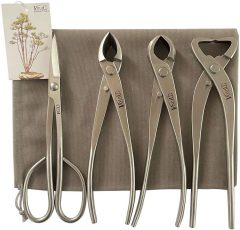
This set of attractive stainless steel tools is a great way to begin pruning and trimming bonsai.
This set of attractive stainless steel tools is a great way to begin pruning and trimming bonsai.
Four-piece tool set made of attractively finished stainless steel. Includes 8t-inch bonsai scissors for fine pruning, plus knob cutter, concave cutter, and trunk splitter. Comes in a cloth bag.
Some have had issues with quality and sturdiness.
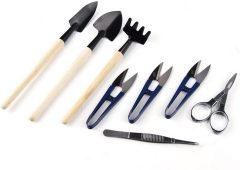
If your focus is soil care and bonsai trimming, this is a good pick.
If your focus is soil care and bonsai trimming, this is a good pick.
With 4 tools designed to prepare soil and 4 to fit your bonsai trimming needs, this set is ideal for beginners and enthusiasts. Includes a storage pouch and tweezers.
Complaints of bending and breaking of the tools have been noted.
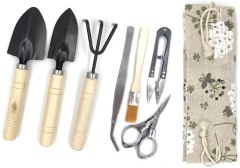
Durable workmanship and an attractive storage bag that are ideal for novice bonsai hobbyists who only need basic yet useful tools.
Durable workmanship and an attractive storage bag that are ideal for novice bonsai hobbyists who only need basic yet useful tools.
Sturdy tools at an affordable price. Designed for basic bonsai growing needs, such as soil prep and plant pruning. Owners like that they are also practical for succulents. Storage bag included.
Rare reports of missing pieces upon delivery. Only 7 tools — not ideal for bonsai enthusiasts who need more for their craft.
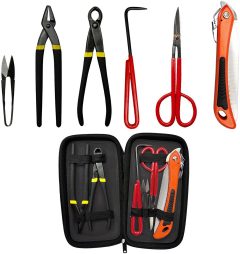
A well-stocked set with nearly everything you need to grow, nurture, and maintain bonsai.
A well-stocked set with nearly everything you need to grow, nurture, and maintain bonsai.
A comprehensive array of tools for most aspects of the art of bonsai, from preparing soil to shaping and trimming plants. Carbon steel construction. Set includes a spacious nylon storage case.
A few complaints of tools breaking or bending. Some rust issues.

This basic set is an excellent option for beginners and makes a great gift.
This basic set is an excellent option for beginners and makes a great gift.
An entry-level kit that includes the basics of bonsai; a rake, brush, trimmer, and tweezers. We love that the rake and brush are made of bamboo. Comes in a case that's perfect for gifting.
Not enough tools for serious gardening. Trimmers may not work on thick plants.

We recommend these products based on an intensive research process that's designed to cut through the noise and find the top products in this space. Guided by experts, we spend hours looking into the factors that matter, to bring you these selections.
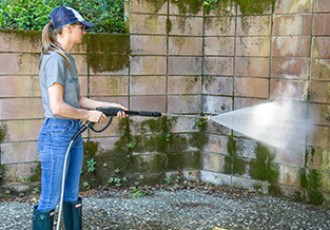
Few hobbies are as relaxing and rewarding as bonsai gardening. The art form, which has been around since the twelfth century, allows you to patiently train trees and shrubs to grow into miniature versions of themselves. However, to produce the best results, you need a quality bonsai tool kit.
In order to do your finest work, you need a bonsai kit that features a variety of durable tools, each designed for a specific purpose. Since you will be required to make precise cuts, all of your pruning and cutting tools need to have very sharp edges.
This article walks you through the basics of bonsai gardening so you can better understand what you need in a bonsai tool kit. If you want to learn about the art form, keep reading. If you've just stopped by this page for our recommendations, consider one of the bonsai tool kits that we've spotlighted in this guide.

Bonsai is an art form that has been around for approximately 800 years. Over that time, the techniques have advanced and some very specific tools have been developed. When starting out, however, you can do most of your gardening with just a few essentials.
Shear: The shear is the multipurpose cutter. It comes in a wide variety of shapes and sizes. This handy tool can snip twigs, small branches, roots, and leaves. The most important aspect is the tool's sharpness: a sharp shear cuts precisely and cleanly without damaging the tree.
Concave branch cutter: When there is a branch growing out of the trunk that you want to remove, you need a concave (rounded) tool so you can cut into the trunk. If you do not cut into the trunk when removing a branch, the tree will form a swollen scar as it heals.
Wire cutter: Although it might be difficult to find an inexpensive bonsai tool kit that includes a wire cutter, it’s an essential tool to have since you need to cut the wire that’s used to shape the tree's trunk and branches. If you use a shear or concave branch cutter to snip the wire, you’ll ruin the tool's sharp edge. Additionally, the rounded end on the bonsai wire cutters means you won't inadvertently damage the tree while cutting wires.
The tools in the previous section are enough to get you started, but if you have more specific tools, you’ll be better prepared to try more advanced bonsai techniques. Here are some other tools that could come in handy depending on your level of expertise.
Leaf cutter: If you'd like to remove the leaves from your bonsai tree to induce growth, you could use just about any cutting tool in your kit. However, a leaf cutter is specifically designed for the job, making it much easier to defoliate your tree.
Root cutter: When your bonsai tree’s root ball needs a little thinning, you could use a shear for the job. However, since the roots are tougher than the branches, and you might accidentally catch a piece of soil or gravel when snipping, the task is more easily accomplished if you have a root cutter in your tool kit.
Knob cutter: If you didn't use a concave branch cutter to remove a branch, eventually, a swollen lump will grow where the branch once was. Those tough bulbous forms are called knobs. A knob cutter gives you a second chance, allowing you to bite deeper into the tree, remove the knob and leave a wound that can heal flush with the tree instead of producing another knob.
Jin pliers: A jin is a branch that has been stripped bare. Jin pliers allow you to crunch the growing outer layer of a branch (the cambium layer) to easily remove it, leaving behind a bare branch. This technique can also be used on the trunk to remove the bark.
Jin carving tools: Instead of a set of pliers, you can remove the cambium layer of a tree with a scraping tool that somewhat resembles a vegetable peeler. Jin carving tools come in different shapes and can be used as an alternative to or in addition to jin pliers.
Bonsai keyhole saw: If you have particularly difficult branches or roots to remove, a tiny bonsai keyhole saw is the best tool for the job. The sharp teeth allow you to quickly slice through even the stubborn taproot if needed.
Grafting knife: Sometimes, you need to fuse two trees or parts of trees together. Although there are several techniques that can accomplish this, a grafting knife allows you to shape the two parts so they interlock. Additionally, the grafting knife can be used in any situation where a sharp knife is needed.
Trunk splitter: If the trunk of the bonsai tree isn't aesthetically pleasing, a trunk splitter can help you solve that problem.
Tree branch bender: Like it sounds, this tool is used to shape various parts of your bonsai tree. The best ones are coated in vinyl to help protect the tree.
Landscaping tools: Whether it's a rake or a spade, if your bonsai kit comes with a variety of landscaping tools, you’ll be much better equipped to tend to the soil of your bonsai tree.

Bonsai is not a one-size-fits-all type of hobby. There will be times when you need a larger or smaller version of a particular tool. When this happens, you’ll be grateful to have two or three different sizes of that particular tool. The wider the variety of differently sized tools you have, the better equipped you will be to handle any pruning or shaping challenge.
Inexpensive bonsai tool kits feature a tiny satchel to hold your tools. Higher-end kits may have a leather case or wooden box. If the container is important to you, look for a bonsai tool kit that has the type of case you prefer.
Inexpensive: A no-frills starter bonsai kit costs between $7 and $15. In this range, you get a basic pruning tool that is straight and operates more like tweezers than scissors, probably a miniature rake and shovel, but nothing that serves as wire cutters (do not use the pruning tool to cut wires). The tools may also come with a satchel to keep them all in one spot.
Mid-range: In the $25 to $50 range, you can find high-quality individual tools and decent-quality kits. Some of the best kits in this price range may only feature three tools, but those tools will likely be made of metal and offer concave cutting, which is a much better option for pruning. Also in this range you may find convenient starter kits that come with seeds, soil, and pots, as well as tools. Be careful, the quality of these kits may be lacking because it's not cost effective to offer all of these items at such a low price.
Expensive: Between $60 and $100 is where the serious bonsai enthusiast wants to look. These tools are durable and likely made of carbon steel, and the kits include several specialty items that aren’t found in lower-priced kits. These kits usually come with a wooden storage box to prevent misplacing the individual tools. Of course, there are much more expensive kits, but be wary because you might not experience an increase in benefits that would justify the additional cost.
Select the right tree. Before you can let your creativity blossom, you need a canvas. In bonsai, the tree is your canvas.
Remember the three most important factors. Although bonsai trees are more delicate than other plants, water, fertilization, and location are the three most important factors that will help your tree stay strong.
Learn how to prune. Pruning is the key. By learning how to judiciously prune, you can keep your tree small and shape it to look natural. For most trees, the best time to prune is during the growing season, in spring and summer. If two branches are growing from the same area, a good rule of thumb is to prune away one of them. The most unnatural look is a bonsai tree with thick upper branches. Be sure to prune those away.
Defoliation works. One technique to get your tree to grow better leaves is to trim all of the existing ones off during the summer so new leaves are encouraged to grow.
Use wire to shape the tree. Wrapping wire around the branches or the trunk of your tree will allow you to shape the way your tree grows. But remember that wire is temporary. If you leave the wire on too long, it will damage the tree.

Q. How does bonsai work?
A. Turning a tree into a miniature work of art takes a great deal of dedication and patience. It also requires know-how. These are not special, genetically altered plants that grow in miniature; they are regular trees and shrubs that are trained to remain small through a variety of pruning and wiring techniques.
Q. How do I know which tree is best for me?
A. The best first step is to simply select a tree that is indigenous to your area. Next, you need to decide if you’ll grow your tree indoors or outdoors and select one that will thrive in those conditions. Finally, you want to pick a tree that you find aesthetically pleasing. A ficus is a good indoor choice for beginners because it’s a fairly durable tree.
Q. Do I need to start a tree from scratch?
A. If you're apprehensive about entering the world of bonsai, you can purchase a pre-bonsai tree. This special type of tree has already been started and partially trained, but it hasn't reached its final form. With this type of tree, you get a head start, but you’re still able to shape and train the tree however you desire.
Get emails you’ll love.
Learn about the products you’re wondering if you should buy and get advice on using your latest purchases.
